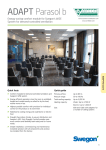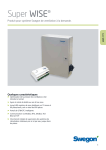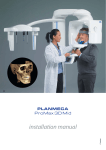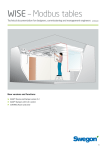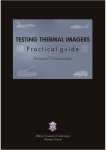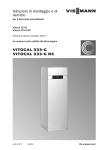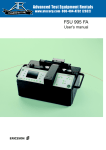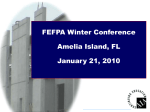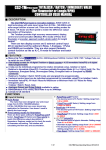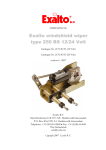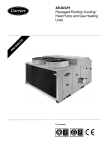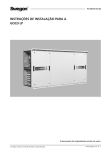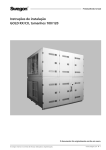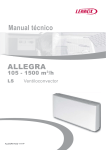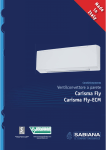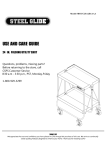Download ADAPT Parasol EX b
Transcript
ADAPT Parasol EX b Energy-saving, suspended comfort module for Swegon’s WISE System for demand-controlled ventilation www.eurovent-certification.com www.certiflash.com ADAPT Parasol EX b ►► Suspended comfort modules for demand-controlled ventilation and Swegon’s WISE system. Primary airflow: Up to 55 l/s ►► Energy-efficient operation since the room is ventilated, heated and cooled exactly as called for by the load, neither more nor less. Pressure range: 50 to 150 Pa Total cooling capacity: Up to 1930 W Heating capacity: Up to 2450 W Size: 690 x 690 mm ►► Highest possible comfort with provision for individual control on the product or at room level. ►► Waterborne cooling and heating. 690 x 1290 mm Height 230 mm. ►► Draught-free indoor climate, 4-way air distribution and Swegon’s ADC (Anti Draught Control) provide maximum comfort and flexibility both today and for future needs. 1 ADAPT Parasol EX b Flexibility The easily adjustable nozzles in combination with Swegon’s ADC (Anti Draught Control) offer maximum flexibility for future changes in the room layout. All sides of the unit can be set independently of one another and this enables the comfort module to distribute more air or less air to each of the four sides and deliver the air in the preferred direction in the room. Design ADAPT Parasol EX comfort module The ADAPT Parasol EX is based on a standard Parasol EX but is also equipped with functions for demand control of the indoor climate. Available as single and two-module units: Sizes: 690 x 690; 690 x 1290 Modules: Supply air and cooling Supply air, cooling and heating Installation: Suspended, close to ceiling Function The essential function of the comfort modules is closely related to that of climate beams. The major difference is that comfort modules distribute air in four directions instead of two. This maximizes the area for the induction of room air with the supply air which enables the modules to deliver a high capacity without occupying more ceiling space than necessary. The comfort modules are also optimized to quickly mix the supplied air with the room which provides better comfort in the room. In heating applications, this technique also ensures heat is conveyed along the ceiling in a better way. The built-in DCV function assumes that the duct pressure is maintained constant by means of a zone damper for example. The face plate of the ADAPT Parasol EX is available in three different perforation patterns. As standard, the face plate has round perforations arranged in a triangular pattern however other optional patterns are available to special order. Draught-fee indoor climate The ADAPT Parasol EX distributes air in four directions at low air velocity. The low air velocity is created by distributing air cooler than room temperature over a large area. The special design of the outlet creates a turbulent flow enabling the supply air to be quickly mixed with the room air. The comfort module’s closed design with a circulation opening for recirculated air in the face plate of the module also contributes to its excellent mixing performance. The ADAPT Parasol EX is available in the following coil/ heat exchanger variants: Variant A: Supply air and waterborne cooling from coil. Variant B: Supply air, waterborne cooling and heating from coil. Demand-controlled indoor climate Demand-controlled ventilation involves ventilating and conditioning the air in a room precisely to meet our needs – no more and no less. The potential for savings is substantial, especially in premises where there is considerable variation between low and high load conditions in rooms and during times when there are few or no occupants which is the case in many premises. Offices for example have in many cases an occupancy rate of less than 50 %! The ADAPT Parasol EX combines the best attributes from two worlds – demand-controlled ventilation with all its potential for savings combined with the comfort module’s high capacity and performance for air conditioning rooms. 2 Swegon reserves the right to alter specifications. 2015-03-31 www.swegon.com ADAPT Parasol EX b Figure 1. Variant A: Cooling and supply air operation 1 = Primary air 2 = Induced room air 3 = Primary air mixed with chilled room air ADAPT Parasol EX b Figure 2. Variant B: Heating and supply air operation (also includes cooling operation) 1 = Primary air 2 = Induced room air 3 = Primary air mixed with heated room air Swegon reserves the right to alter specifications. 2015-03-31 www.swegon.com 3 ADAPT Parasol EX b Compact and intelligent unit The ADAPT Parasol EX is supplied as a compact and intelligent unit in which the damper and motor are integrated into the product. The controller with pressure sensor and wiring terminals are pre-mounted on a mounting plate, which can be easily fitted onto the duct where it will be concealed by the duct casing. The sensor module, which is a vital part of the product, is a combined presence detector and a temperature sensor. Its default location is within the face plate, however it can also be mounted on a wall. The package together with its intelligent control system where numerous adaptations can be made, contribute to making the product very flexible and future secure proof. As an example, it is noteworthy that all the units can operate as master or slave, simply adjustable by changing a parameter together with repositioning an RJ cable. This means that in the event an open-plan office, for example, is divided up into office cells, the extra work involved in adapting the product to the new operating conditions is minimized. High capacity With its high capacity, the ADAPT Parasol EX utilizes 40-50% less ceiling area for handling the cooling load in a normal office, compared with a traditional climate beam. Simple to adjust By means of built-in nozzle regulation with numerous possible settings, the ADAPT Parasol EX offers optimum comfort and can be easily adapted to meet a change in room size or operations conducted inside the premises. The comfort module can be set so that different air volumes are diffused on each side and can be set for both high and low airflows. Range of Application The ADAPT Parasol EX is ideal for use as a standard application in such premises as: • • • • • • • Offices and conference rooms Classrooms Hotels Restaurants Hospitals Shops Shopping centres With its numerous possible settings, the functions of the ADAPT Parasol EX can easily be adapted to new businesses or changes in the design of the premises. Location Since each side of the ADAPT Parasol EX is individually adjustable to provide the appropriate airflow, the comfort modules can be positioned anywhere in the room. Whether they are located at the front edge, centre, and rear edge or symmetrically in the room is of no importance. In rear edge solutions for cellular offices, for instance, the unit can be installed near the corridor wall. The only operation that needs to be done is to reduce the volume of air distributed towards the corridor wall and instead open up more on the three other sides (see Figure 3). This is of benefit in comparison with other rear-edge solutions, because you can make use of the partition walls to increase the air mixing zone. This provides low air velocities and a healthy room climate. Simple to install The small dimensions offer benefits in handling, especially at the building site, with easier installation and reduced health and safety issues. Figure 3. ADAPT Parasol EX as a rear-edge solution 4 Swegon reserves the right to alter specifications. 2015-03-31 www.swegon.com ADAPT Parasol EX b truktur Chiller and heat pump NESTOR truktur System Internal network/ Internet Central intelligent building automation System System system truktur truktur system Zone System Subsystem All Year Comfort Super WISE System Zone Room system GOLD system Room roduct Zone Zone roduct ) Zone parts Room CONTROL Zone CONTROL Zone CONTROL Zone ADAPT Parasol EX b )Room parts onents roduct Room roduct onents ) parts ADAPT Damper ) parts onents onents Passive air diffusers ADAPT active air diffusers ADAPT Parasol EX Figure 4. Component of the WISE system The ADAPT Parasol EX is a component of Swegon’s WISE System for demand-controlled ventilation. Via the SuperWISE, a communication unit, which, via Modbus RTU, ties all the components in the WISE system together, ADAPT Parasol EX communicates with other WISE products in the system and all the way up to the GOLD air handling unit. Swegon reserves the right to alter specifications. One of the advantages with the ADAPT Parasol EX is that the pressure in the nozzles can be kept at a high level, and this means controlled throw lengths, high capacity and maintained Coanda effect of the air regardless of the operating conditions. The Swegon CONTROL Zone damper is used for maintaining constant pressure in the zone. 2015-03-31 www.swegon.com 5 ADAPT Parasol EX b Demand-controls the climate in the room • Stepless regulation of the airflow as required – temperature or the air quality. • If an air quality sensor is used, it overrides the temperature sensor. • Same stepless function regardless of whether it concerns one product in an individual-room office or several products in an open-plan office or a conference room. • Besides ventilating in an efficient way, the room temperature is regulated by means of both waterborne and airborne cooling. • Can advantageously discharge heated air from the ceiling – all in one product • Can be combined with radiators or floor heating – the product then takes this into consideration and regulates the room temperature in an energy-efficient way, for example by increasing the airflow on increased heat demand. Selection of sequence, Water / Air • T he control sequence involves prioritising waterborne cooling before airborne cooling • For an occupied room, the airflow is steplessly regulated between min. and max. depending on the room temperature (or the air quality if an air quality sensor is used). • If the room needs to be cooled, ensure first that the airflow generates sufficient pressure in the module which will allow the water valve to open. The reason for this is to ensure comfort in the room, i.e. to prevent cold down draughts from the product. • After that the water valve is allowed to open to supply chilled air to cool the room. If there is still a cooling demand when the cooling valve is fully open, the built-in air damper opens to cool more with air. Flow Water / Air 1 2 3 4 5 6 Max. occupancy flow Min. P cooling valve Min. occupancy flow Valve 100% open Vacancy flow Valve 0% open Occupancy with cooling demand Figure 5. 1. Occupancy – temperature rises 2. The room temperature reaches level for cooling demand – air damper opens in order to reach minimum pressure which alllows cooling valve to open. 3. Cooling valve is allowed to open 4. Cooling valve is fully open but there is still a cooling demand in the room – the air damper opens in order to cool with more air 5. Cooling valve and air damper fully open 6. The temperature reaches the room set point; the damper and valve close = Water = Air = Room temperature 6 Swegon reserves the right to alter specifications. 2015-03-31 www.swegon.com ADAPT Parasol EX b Selection of sequence, Air / Water • T he control sequence involves prioritising airborne cooling before waterborne cooling • For an occupied room, the airflow is steplessly regulated between min. and max. depending on the room temperature (or the air quality if an air quality sensor is used). • If there is a cooling demand, the air damper first steplessly opens to the fully open position; if a cooling demand remains the water valve also opens. Flow Water / Air 1 2 3 4 5 Max. occupancy flow Min. occupancy flow Valve 100% open Vacancy flow Valve 0% open Occupancy with cooling demand = Water = Air Figure 6. Sequence, Air quality Flow / Air 1 2 4 3 Max. occupancy flow Min. occupancy flow Vacancy flow Occupancy with increased airflow to improve air quality = Air Figure 7. = Room temperature 1. Occupancy – CO2 / VOC content rises 2. CO2 / VOC content reaches the permissible upper limit value – the air damper steplessly opens 3. Fully open air damper 4. CO2 / VOC content reaches the permissible lower limit value – the air damper closes Swegon reserves the right to alter specifications. 2015-03-31 www.swegon.com 7 ADAPT Parasol EX b = Room temperature 1. Occupancy – temperature rises 2. Room temperature reaches level for cooling demand – air damper opens 3. Cooling valve is fully open but cooling is still required in the room – the valve opens in order to cool with water 4. Air damper and water valve fully open 5. The temperature reaches the room set point; the damper and valve close ADAPT Parasol EX b Operating mode Depending on the status of connected sensors, the controller adjusts the outputs from any of several possible operating conditions. The operating conditions based on occupancy in the room, the status of the sensor in use or signals from a main control system are described below. Operating modes There are numerous functions in the ADAPT Parasol EX: • Occupancy mode. • No occupancy mode. • Holiday. • Stand-by, idle mode. • Emergency mode. • • Stand-by, idle mode When the control system registers that a window is open, the controller switches over to the Stand-by mode. When the window is closed, the controller switches over to the Occupancy mode. The controller is in the Stand-by mode, the room temperature is kept above 10°C (frost protection). Emergency mode In the event of a fire alarm, the controller opens or closes the air damper in the extract air duct, depending on how the control system is set. In the Emergency mode, cooling and heating are switched off. Supply air is normally switched off. The Emergency mode can only be managed in control systems that are connected to a main control system via Modbus RTU. Commissioning. Summer night cooling. Occupancy mode When the ADAPT Parasol EX receives signals via presence detector indicating that someone is in the room, the valve actuator for chilled water or heating water as the case may be is controlled according to the selected temperature setpoint for cooling or heating associated with this operating mode. The airflow is controlled to the preselected occupancy flow, but is influenced of course by sensors such as condensation sensors, temperature sensors, window contacts, air quality sensors, if required, etc. No occupancy mode When the No occupancy mode function is active, the system automatically switches over to the energy-save mode. The system returns to the Occupancy mode and normal operation when occupancy is registered again. In the energy-save mode/no occupancy mode, the valve actuator is controlled to regulate the chilled water flow or hot water flow according to the status on other sensors in the room, but normally with a greater permissible deadband from the temperature setpoint for cooling or heating than in the occupancy mode, whilst the air is controlled to the min. flow setting. Commissioning level The “First open” function involves having the water valves open while the installation work is in progress, which simplifies filling, pressure testing and venting the water system The function will be automatically deactivated after approx. 6 minutes while the system is energised. A clicking noise can be heard when the valves and dampers change over to the NC mode (normally closed) and the normal control function is activated. Further particulars of the commissioning mode can be read in the description of the sensor module on page 12. Summer night cooling The function involves the use of cold air from outdoors for cooling the room at night to the predefined level. The function can only be handled in the control system that is connected to a main control system via Modbus RTU. Holiday. When the Holiday operating mode is active, the system automatically switches over to the energy-save mode just as in the case of the No Occupancy mode, but with scope for allowing further greater temperature differential. Controlled from a main control system. 8 Swegon reserves the right to alter specifications. 2015-03-31 www.swegon.com ADAPT Parasol EX b Functions SWICCT: Change over The function involves the use of only one valve actuator which should be wired to the cooling output terminal. This actuator then controls both the heating water and the chilled water, which is transported in the same pipe. An external temp. sensor should be used and this component should take measurements on the pipe through which water always circulates. In winter, when heating is required, the valve opens if the water in the pipe is warmer than the temperature set point. If the water is colder, the valve does not open. In summer, when cooling is required, the valve opens if the water in the pipe is colder than the temperature set point. GT1 GT2 RE External temperature sensor use Change over temperature Not used Room temperature Change over temperature Temperature (read only) Window contact NO Window contact NC Figure 9. Exercising of valves The function involves exercising the water valves regularly by means of automatic control equipment to prevent them from seizing or becoming stuck. During the exercising process, all the valves wired to the controller open to the max. setting for 6 minutes and then close. The valves of the cooling system are exercised first; after that the valves of the heating system are exercised. Room Figure 8. • 2-pipe system with chilled water in the summer and heated water in the winter • GT1 is located where heated or chilled water always circulates • Summer: If the room temperature T2 is higher than the water temperature T1 the valve opens if there is a cooling demand. • Winter: If the room temperature T2 is lower than the water temperature T1 the valve opens if there is a heating demand. • GT1 is wired to the controller as an external temperature sensor. • In the SWICCT or SuperWISE, the operator has enter a setting in the controller indicating that the sensor is to be used for Change-Over operation. • GT2 is the temperature sensor that is mounted in the Sensor module • The valve actuator should be wired to the cooling output of the controller. Swegon reserves the right to alter specifications. 2015-03-31 www.swegon.com 9 ADAPT Parasol EX b Frost protection The function involves starting heating operation at 10°C to prevent the risk of damage that otherwise could occur due to freezing. ADAPT Parasol EX ADAPT Parasol EX b Specific nozzle settings To specify nozzle settings, always begin from the side where the water pipes are located. From there, proceed in counterclockwise direction and specify side after side, see Figures 10 and 12. Units can be ordered with nozzles factory-preset (this does not apply to units held in stock). Nozzle setting The unique built-in nozzle control in the ADAPT Parasol EX makes it possible to individually set each one of the four sides. Depending on the unit’s location and the room’s primary air requirement, the primary air can be guided in all desired directions. The direction of the airflow can be easily optimized using the Swegon ProSelect sizing program that is available from www.swegon.com. The required nozzle setting is preset from the factory, but if required it can be simply changed at the site. K-factor Figure 10. Top view, sides 1-4 ADAPT Parasol EX 690 Figure 12. Example 1. A = 2.1 l/s, B = 15.3 l/s Figure 11. Top view, sides 1-4 ADAPT Parasol EX 1290 Each nozzle setting has a specific K-factor. A total K-factor for the unit can be determined by adding together the K-factors for the nozzle settings on each side. The relevant K-factor for optimized nozzle setting can also be obtained in ProSelect. Figure 13. Example 2. A = 5.8 l/s, B = 15.3 l/s Example 1: Nozzle setting LHLH produces the lowest possible No Occupancy flow (sides 1 + 3 open). This produces a min. flow/no occupancy flow of approx. 4 l/s and a max. flow of approx. 35 l/s at pi = 70 pa Example 2: If it is instead more important to obtain the highest possible max. flow/capacity, the nozzles should be set to the HHHH position, i.e. fully open on all sides. A higher max. flow will then be obtained, however the No Occupancy flow will consequently also be slightly higher. Figure 14. Nozzle setting These adjustments are only different settings on the same physical product which makes the unit very flexible and adaptable, particularly together with the integrated software. K-factors for each side can be obtained from Tables 2-5 or from the installation instructions on the Internet, however the easiest way to do this is in ProSelect where you can quickly test various variants. 10 Swegon reserves the right to alter specifications. 2015-03-31 www.swegon.com ADAPT Parasol EX b The sensor module The sensor module consists of a presence detector and a temperature sensor in the same unit. This component is mounted as standard in the face plate on the ADAPT Parasol EX but it can also be ordered as an accessory for wall mounting, and in that case either recessed in a standard electrical component box or surface-mounted on the wall. By pressing the appropriate buttons on the sensor module, you can adjust the temperature in the room, set the ADAPT Parasol EX to the commissioning mode and read the alarm list. 6 light-emitting diodes indicate in the normal mode which temperature level has been selected. If an error occurs, the current alarm is shown as a series of flashes that are translatable using an alarm list. Use an RJ12 cable to connect the sensor module to the controller. The floor area covered by the presence detector is approx. 24 m2 if it is mounted at a height of 2.7 metres above the floor and in parallel with the floor. Entering temperature adjustments To raise the temperature setting, press down the right-hand button. Each diode corresponds to a one degree increase or decrease of the set point. The base setting of temperatures is entered in SWICCT or SuperWISE Presence detector Diodes for temperature, commissioning or alarm indication Figure 17. The CABLE CONVERTER USB-RJ12 (RS485) cable can be easily used for connecting a computer to the module for e.g. entering software settings. The cable can be connected either to a socket on the rear of the Sensor module as illustrated, or directly to the controller. How this is done is described in the SWICCT user's manual. Function buttons Diode-indicating function - Green = Ok - Yellow = Alarm - Green/Yellow = Comfort alarm (not acute) Temperature sensor Figure 15. Sensor module viewed from the front ON 1 2 3 parallel RJ12 ports (Modbus) for connecting a controller for instance, another sensor module or computer by means of Cable converter USB-RJ12 Addressing the sensor module. 10 sensor modules can be connected to each master unit. Each one must have its own unique address in order to work. Switch for termination resistance. Set Switch 1 to the ON position for the last sensor module in the loop. Figure 16. Sensor module viewed from rear Swegon reserves the right to alter specifications. 2015-03-31 www.swegon.com 11 ADAPT Parasol EX b To lower the temperature setting, press down the left-hand button. ADAPT Parasol EX b SWICCT SWICCT (SWegon Indoor Climate Configuration Tool) is the software that makes the entering of settings into the controller a simple task. Here you can make all the necessary settings for the Product, for example: • • • • Base settings for temperature how to use external sensors, e.g. for air quality Airflows Commissioning SWICCT can be downloaded from www.swegon.se; both the software and a separate manual. 12 Swegon reserves the right to alter specifications. 2015-03-31 www.swegon.com ADAPT Parasol EX b Typical installations: 2 GP 2 2 2 GP GP GP x3 3 RE RE 1 1 4 5 3 6 4 1. ADAPT Parasol EX comfort module with supply air, cooling and heating • Pressure sensor • Communication unit/controller • Damper with motor. 2. CONTROL Zone damper 3. Extract air diffuser 4. Cooling water and heating water 5. Extract air via transfer air grille to the corridor 6. External sensor module (occupancy and temperature sensor) Swegon reserves the right to alter specifications. 5 Figure 19. Typical room 2 shows ADAPT Parasol EX in an office room Supply and extract air in balance. 1. ADAPT Parasol EX comfort module with supply air and cooling • Pressure sensor • Presence detector • Temperature sensor • Communication unit/controller • Damper with motor. 2. CONTROL Zone damper 3. Chilled water 4. Extract air via ADAPT Damper slave-controlled from ADAPT Parasol EX 5. Grill or fully opened extract air register (EXC) 6. Sound attentator CLA/SORDO 2015-03-31 www.swegon.com 13 ADAPT Parasol EX b Figure 18. Typical room 1 shows ADAPT Parasol EX in an office room Extract air via transfer air grille (balance at zone level) 6 ADAPT Parasol EX b ADC All comfort modules are supplied with ADC air deflectors. ADC stands for Anti Draught Control, which enables you to set the diffusion pattern of the air being distributed to avoid risk of draught. A number of ADC sections with four air deflectors per section are arranged on each side of the unit. Each section is adjustable from a straight setting to 40° air deflection to the right or left in increments of 10°. This offers enormous flexibility and can be easily adjusted without affecting the sound level and the static pressure. The water capacity is reduced by 5 - 10% when the ADC is adjusted to "Fanshape". Figure 21. Possible settings for the ADC, Fan-shape Figure 22. Possible settings for the ADC, X-shape Figure 20. ADC, setting range from -40° to +40° in increments of 10° 0° Figure 23. Possible settings for the ADC, Straight airflow setting 14 Swegon reserves the right to alter specifications. 2015-03-31 www.swegon.com ADAPT Parasol EX b Technical data Recommended limit values Pressure levels Total cooling capacity, max. 1930 W Working pressure, coil, max. Total heating capacity, max. 2450 W Test pressure, coil, max. 2400 kPa * * Applies to module without installed control equipment Airflow Single module unit Two-module unit 7-34 l/s 9-55 l/s Nozzle pressure 50-150 Pa Recommended lowest nozzle pressure if coil heating is used, pi70 Pa Length Single module unit Two-module unit 1600 kPa * Recommended lowest nozzle pressure with the face plate in the high capacity position, pi 70 Pa 690 mm 1,290 mm Water flow Width690 mm Ensures evacuation of any air pockets in the system. Height230 mm Cooling water, min. 0.030 l/s Dimensions of the units have a tolerance of (±2) mm. Heating water, min. 0.013 l/s Temperature differentials 690 A 2-5 K Heating water, drop in temperature 4-10 K Temperature differences are always expressed in Kelvin (K). Table 1. Weight ADAPT Parasol EX Chilled water, temperature increase Flow temperature Dry weight Chilled water volume Heating water volume 21.4 20 21.2 Heating water, max. ** Chilled water must always be kept at a level that ensures that no condensation will form. 22.6 20.6 22.1 1290-A 34.4 30.8 32 1290-B 39.1 34.8 37.2 60ºC ADAPT Parasol EX b 690-B Chilled water** Exkl. sensor module 0.1 kg. Designations P Power consumption Power consumption for dimensioning transformer: Capacity (W) tl Temperature of the primary air (°C) tr Temperature of the room air (°C) tm Mean water temperature (°C) ∆Tm Temperature differential tr- tm (K) Actuator 6 VA ∆Tl Temperature differential tl- tr (K) Damper motor 2 VA* Controller 1 VA* ∆Tk Temperature differential between the cooling water inlet flow and return (K) Sensor Module 1 VA* ∆Tv Temperature differential between the heating water inlet flow and return (K) v Water velocity (m/s) q Airflow (l/s) p Pressure (Pa) ∆p Pressure drop (Pa) * Allways included in product Example A: ADAPT Parasol EX 1290-B-HF; 6+2+1+1 = 10 VA 6 VA for cooling OR heating actuator as the normally operate in sequence. Supplementary index: k = cooling, v = heat, l = air, i = commissioning, corr = correction Example B: ADAPT Parasol EX 1290-B-HF; 6+6+2+1+1 = 16 VA For Radiator Heat and Cold draught protection, means 6+6 VA for actuators as they don´t operate in sequences. Nozzle pressure (commissioning pressure) pl = (ql / kpl) 2 pl Nozzle pressure (Pa) ql Primary airflow (l/s) kpl Pressure drop constant for nozzle setting, see Tables 2-3 Swegon reserves the right to alter specifications. 2015-03-31 www.swegon.com 15 ADAPT Parasol EX b Cooling Corrected capacity – water flow Standard The cooling capacities have been measured in conformance with EN 15116 Standard and have been recalculated for a constant water flow according to Diagram 2/3. Different water flow rates to some extent have effects on the capacity output. By checking obtained water flow against Diagrams 2 or 3, the capacity indicated in Tables 2-3 may need to be slightly adjusted up or down. Pcorr = k · Pk PcorrCorrected capacity (W) Calculating formulae – Cooling Below are formulae that enable the user to calculate what comfort module is best suited for the application. The values for the calculations can be taken from the tables. Pressure drop in cooling coil ∆pk = (qk / kpk) 2 ∆pk qk k Correction factor Pk Cooling capacity of the water Diagram 2. Corrected capacity – Water flow, ADAPT Parasol EX 690 Pressure drop in cooling coil (kPa) Flow of chilled water (l/s), see Diagram 1 kpk Pressure drop constant for cooling coil, see Tables 2-3 Cooling capacity of the air Pl = 1.2 · ql · ∆Tl Pl Primary air cooling capacity (W) ql Primary airflow (l/s) ∆Tl Temperature differential between primary air (tl) and room air (tr) (K) Cooling capacity of the water Pk = 4186 · qk · ∆Tk Pk Cooling capacity of the water (W) qk Chilled water flow (l/s) ∆Tk Temperature differential between the cooling water inlet flow and return (K) Diagram 3. Corrected capacity – Water flow, ADAPT Parasol EX 1290 Diagram 1. Water Flow – Cooling Capacity Pk (W) 1500 Tk (W) (°K) = 5 °K 4 °K 1250 3 °K 1000 2 °K 750 500 1 °K 250 0 0,03 0,04 0,3 16 0,05 0,4 0,06 0,5 0,07 0,6 0,08 0,7 0,09 0,8 Swegon reserves the right to alter specifications. qk(l/s) 0,10 0,9 v(m/s) 2015-03-31 www.swegon.com ADAPT Parasol EX b Diagram 4. Pressure drop – Chilled water flow 90 0 12 69 Table 2. Cooling capacity of the ADAPT Parasol EX 690 Nozzle pressure Nozzle setting 1) Primary airflow rate Sound level, dB(A) 2) (l/s) 50 Pa 90 Pa 7.2 <20 Cooling capacity of the water (W) Pressure drop constant air/water for ∆Tmk 3) 6 8 10 12 6 7 8 9 10 11 kpl kpk 52 69 86 104 166 194 219 246 271 298 1.01 0.0173 LHLH 13.4 <20 96 129 161 193 218 254 287 323 359 392 1.89 0.0173 HHHH 19.6 20 141 188 235 282 236 275 315 354 390 429 2.77 0.0173 LLLL 8.5 <20 61 82 102 122 197 226 259 288 321 353 1.01 0.0173 LHLH 15.8 24 114 152 190 228 257 299 337 378 420 461 1.89 0.0173 HHHH 23.2 25 167 223 278 334 278 323 368 413 458 498 2.77 0.0173 LLLL 9.6 20 69 92 115 138 217 254 287 323 359 392 1.01 0.0173 LHLH 17.9 27 129 172 215 258 283 329 375 420 466 507 1.89 0.0173 HHHH 26.3 29 189 252 316 379 310 360 409 458 502 551 2.77 0.0173 Table 3. Cooling capacity of the ADAPT Parasol EX 1290 Nozzle pressure Nozzle setting 1) Primary airflow rate Sound level, dB(A) 2) (l/s) 50 Pa 70 Pa 90 Pa Cooling capacity of primary air (W) for ∆Tl Cooling capacity of the water (W) Pressure drop constant air/water for ∆Tmk 3) 6 8 10 12 6 7 8 9 10 kpl kpk LLLL 13 <20 94 125 156 187 349 404 459 515 569 1.84 0.0183 LHLH 29.4 22 212 282 353 423 444 517 583 649 715 4.16 0.0183 HHHH 35.6 26 256 342 427 513 463 531 599 667 740 5.04 0.0183 LLLL 15.4 <20 111 148 185 222 389 457 518 580 641 1.84 0.0183 LHLH 34.8 26 251 334 418 501 498 578 651 730 802 4.16 0.0183 HHHH 42.2 29 304 405 506 608 519 594 669 749 823 5.04 0.0183 LLLL 17.5 <20 126 168 210 252 425 491 558 630 696 1.84 0.0183 LHLH 39.5 29 284 379 474 569 541 626 704 788 864 4.16 0.0183 HHHH 47.8 32 344 459 574 688 555 643 722 807 892 5.04 0.0183 1) For particulars on the sizing of alternative nozzle settings, use Swegon’s ProSelect sizing program available at www.swegon.com 2) Room attenuation = 4 dB 3) The specified capacities could vary depending on the nature of the installation and how the air deflectors have been set. The primary air capacity is not affected. N.B.! The total cooling capacity is the sum of the airborne and waterborne cooling capacities. Swegon reserves the right to alter specifications. 2015-03-31 www.swegon.com 17 ADAPT Parasol EX b 70 Pa LLLL Cooling capacity of primary air (W) for ∆Tl ADAPT Parasol EX b Table 4. Cooling Capacity for natural convection Unit (mm) Cooling capacity (W) for temperature differential, room – water ∆Tmk (K) 6 7 8 9 10 11 12 690 17 21 25 29 34 39 43 1290 41 51 61 72 83 95 107 Calculation example – cooling A cellular office without suspended ceiling having dimensions w × d × h = 2.4 × 4 × 2.7 m is to be fitted with a comfort module. The total cooling demand is estimated to be 50 W/m2 To meet this cooling load, an ADAPT Parasol EX that will generate 50 x 2.4 x 4 = 480 W is required. Design room temperature (tr) 24°C, cooling water temperature (inlet flow/return) 14/16°C and primary air temperature (tl) 16°C produces: ∆Tk= 2 K ∆Tmk= 9 K ∆Tl = 8 K The required primary air flow to the room (ql) has been determined to be 16 l/s. A zone damper ensures that the pressure in the duct should be kept at a constant 73 Pa which in this case produces a nozzle pressure of 70 Pa. The sound emitted from the unit must not exceed 30 dB(A). Solution Cooling The cooling capacity of the primary air can be calculated using the following formula: Pl = 1,2 · ∆Tl · ql Pl = 1,2 · 8 · 16 = 154 W The ADAPT Parasol EX comfort module should therefore be able to generate 480 – 154 = 326 W in cooling capacity on the water side. In Table 2 we can read that one 690 x 592 mm ADAPT Parasol EX with LHLH nozzle settings for a primary air flow of 15.8 l/s generates 378 W in cooling capacity on the water side. This is thus sufficient for meeting the cooling demand in the room. At the same time, this nozzle configuration makes it possible to save a large air volume when the module operates in the no occupancy mode, which in this case involves 4.3 l/s (see ProSelect). As an alternative, the nozzles can be set to the HHHH settings. This then delivers more air when the room is unoccupied (less savings) but an over capacity of air volume and cooling to utilise if, for example, there are often visitors to the office. Chilled water With a cooling capacity requirement of 326 W for the chilled water, the necessary water flow can be read in Diagram 1. With a temperature increase of ∆Tk= 2 K the water flow will be 0.039 l/s. In Diagram 2 we can read that a water flow of 0.039 l/s does not produce a fully turbulent outflow, but that the capacity must be corrected by a reduction factor of 0.97. The loss of capacity can be compensated by calculating the comfort modules required cooling capacity as follows: Pk = 326 / 0.97 = 336 W. A new water flow can be obtained from Diagram 1, qk = 0.040 l/s. The pressure drop can now be read to be 5.5 kPa from Diagram 4. 18 Swegon reserves the right to alter specifications. 2015-03-31 www.swegon.com ADAPT Parasol EX b Heating Heating function The comfort module’s capability of quickly mixing the primary air with the room air, makes the ADAPT Parasol EX ideally suited for managing both cooling and heating. Heating premises with air heated above room temperature delivered from the ceiling is, in other words, an excellent alternative to traditional radiator heating solutions. Some of the benefits achieved include lower installation costs, simpler installation and perimeter walls free from piping and radiators. When you set the ADAPT Parasol EX to maintain a high nozzle pressure, under low airflow conditions, there will be a certain heating capacity, even while the module is operating during weekends, for instance, when the flow is reduced for a longer period. ADAPT Parasol EX b Regardless of the type of heating system installed, it is important to consider the operative temperature in a room. Most people are comfortable when the operative temperature in winter is in between 20–24°C. The optimum comfort requirements are normally met when the room temperature is 22°C. This means that in a room with a cold perimeter wall, the air temperature must be higher than 22°C to compensate for the radiant cooling. In new buildings with normal insulated perimeter walls and normal standards of window glazing, the difference between the room air temperature and the operative temperature is small. But for older buildings with worse windows, it may be necessary to raise the air temperature to compensate for the chilling effect. Different operating scenarios can be simulated easily using the Swegon ProClim Web software where both the room air temperature and operative temperature are specified. Supplying heated air from the ceiling results in some stratification of the air. For a supply flow temperature of max. 40°C, the stratification is non-existent, while at 60°C it can be around 4 K in the occupied zone. This only applies during the warming-up phase, when the room is unused and there is no internal load. When the room is in use, the lighting is on, a computer is running and occupants are in the room, the stratification will decrease or disappear depending on the heating energy demand. When heating with the ADAPT Parasol EX, it is advisable to use an external temperature sensor or an extra sensor module in the room. Swegon reserves the right to alter specifications. 2015-03-31 www.swegon.com 19 ADAPT Parasol EX b Calculation formulae - waterborne heating Below are formulae that enable the user to calculate what comfort module is best suited for the application. The values for the calculations are specified in Tables 5-6. The cooling or heating capacity of the air Pl = 1.2 · ql · ∆Tl Pl The cooling or heating capacity of the air (W) ql Primary airflow (l/s) ∆Tl Temperature differential between primary air (tl) and room air (tr) (K) Heating capacity of the water P v = 4186 · qv · ∆Tv Pv Heating capacity of the water (W) qk Heating water flow (l/s) ∆Tv Temperature differential between the heating water inlet flow and return (K) Diagram 5. Water Flow – Heating Capacity Pressure drop for heating circuit ∆pv = (qv / kpv) 2 ∆pv Pressure drop in heating circuit (kPa) qv Heating water flow (l/s), see Diagram 6 kpv Pressure drop constant for heating circuit, see Tables 5-6 Diagram 6. Pressure drop – heating water flow 20 Swegon reserves the right to alter specifications. 2015-03-31 www.swegon.com ADAPT Parasol EX b Table 5 - Heating capacity, ADAPT Parasol EX 690 Nozzle pressure Nozzle setting 1) Primary airflow (l/s) Sound level Heating capacity, water (W) for DTmv 3) dB(A) 2) 5 50 Pa 70 Pa 90 Pa 10 15 20 Pressure drop constant air/water 25 30 kpl kpv LLLL 7.2 <20 114 190 285 379 473 567 1.01 0.0200 LHLH 13.4 <20 125 248 365 485 600 716 1.89 0.0200 HHHH 19.6 20 135 270 396 524 647 774 2.77 0.0200 LLLL 8.5 <20 110 221 331 442 552 661 1.01 0.0200 LHLH 15.8 24 140 281 416 551 682 816 1.89 0.0200 HHHH 23.2 25 151 304 448 592 733 875 2.77 0.0200 LLLL 9.6 20 124 245 365 488 609 731 1.01 0.0200 LHLH 17.9 27 152 306 453 600 745 890 1.89 0.0200 HHHH 26.3 29 165 327 485 641 797 950 2.77 0.0200 Table 6 - Heating capacity, ADAPT Parasol EX 1290 Nozzle pressure 50 Pa 90 Pa 1) Primary airflow (l/s) Sound level Heating capacity, water (W) for DTmv 3) Pressure drop constant air/water dB(A) 2) 5 10 15 20 25 30 kpl kpv LLLL 13 <20 155 313 584 850 1008 1163 1.84 0.0213 LHLH 29.4 22 199 394 735 1072 1272 1471 4.16 0.0213 HHHH 35.6 26 205 410 760 1110 1311 1515 5.04 0.0213 LLLL 15.4 <20 176 353 658 959 1136 1312 1.84 0.0213 LHLH 34.8 26 220 439 819 1201 1421 1645 4.16 0.0213 HHHH 42.2 29 225 455 846 1237 1466 1691 5.04 0.0213 LLLL 17.5 <20 190 384 712 1044 1234 1428 1.84 0.0213 LHLH 39.5 29 239 474 885 1298 1537 1767 4.16 0.0213 HHHH 47.8 32 245 490 912 1334 1579 1811 5.04 0.0213 ADAPT Parasol EX b 70 Pa Nozzle setting 1) For particulars on the sizing of alternative nozzle settings, use Swegon’s ProSelect sizing program available at www.swegon.com 2) Room attenuation = 4 dB 3) The specified capacities could vary depending on the nature of the installation and how the air deflectors have been set. The primary air capacity is not affected. N.B.! The total heating capacity is the sum of the airborne and waterborne heating capacities. If the primary air temperature is lower than the room temperature, it causes negative impact on the total heating capacity. Swegon reserves the right to alter specifications. 2015-03-31 www.swegon.com 21 ADAPT Parasol EX b Calculation example - heating In a cellular office without suspended ceiling, with dimensions w × d × h = 2.4 × 4 × 2.7 m (the same room as in the example for cooling) there is also a heating demand of 450 W in the winter. The primary air flow should be the same as in the summer case, 16 l/s and the duct pressure is now kept constant. Disign room temperature (tr) 22 °C, heating water temperature (supply/return) 45/39 °C and the primary air temperature (tl) 20 °C produces: ∆Tv = 6 K ∆Tmv = 20 K ∆Tl = -2 K Solution Acoustics Natural attenuation and end reflection natural attenuation ΔL (dB) including end reflection. Table 7. Natural attenuation ΔL (dB) ADAPT Parasol EX 690 Octave band (Hz) Nozzle setting 63 125 250 500 1k 2k 4k 8k LLLL 19 20 17 16 17 16 15 15 MMMM 17 18 15 14 15 14 13 13 HHHH 15 16 13 12 13 12 11 11 Heating The primary airflow of 16 l/s in combination with the primary air temperature of 20 °C produces a negative impact on the heating capacity: 1.2 x 16 x (-2) = -38 W. The required heating capacity from the heating water thus increases to 450 + 38 = 488 W. From Table 7 we obtain from ΔTmv = 20 K and the primary airflow 16 l/s a heating capacity of P v = 585 W from a single module unit with LHLH nozzle settings, which is sufficient for meeting the heating load. Table 8. Natural attenuation ΔL (dB) ADAPT Parasol EX 1290 Octave band (Hz) Nozzle setting 63 125 250 500 1k 2k 4k 8k LLLL 18 19 16 15 16 15 14 14 MMMM 16 17 14 13 14 13 12 12 HHHH 14 15 12 11 12 11 10 10 Heating water With a heating capacity requirement of 488 W and ΔTv = 6 K the necessary water flow is obtained in Diagram 5: 0.019 l/s. The pressure drop for the heating water is calculated on the basis of a water flow of 0.019 l/s and pressure drop constant kpv = 0.0200, which is taken from Table 5. The pressure drop will then be: Δpv = (qv /kpv)2 = (0.019 / 0.0200)2 = 0.90 kPa. As an alternative, the pressure drop can be read in Diagram 6. 22 Swegon reserves the right to alter specifications. 2015-03-31 www.swegon.com ADAPT Parasol EX b ADAPT Parasol EX – Component parts C1 C2 A1 D1 B1 B2 C3 A1: Duct module C1: Guide kit plate B1: Design frame C2: Valve actuator B2: Face plate C3: Sensor module D1: Connection casing (Accessory) with wall mounting bracket C Figure 25. The following is supplied together with each ADAPT Parasol EX: a carton containing a guide plate with mounted controller and pressure sensor, sensor module, valve actuator, as well as other control components which have been ordered as accessories. Swegon reserves the right to alter specifications. 2015-03-31 www.swegon.com 23 ADAPT Parasol EX b Figure 24. The ADAPT Parasol EX is delivered in several sections: A, B, C, D. ADAPT Parasol EX b Installation Recommended types of ceiling The ADAPT Parasol EX is designed for suspended installation from hangers or mounting directly against the ceiling. Suspension The ADAPT Parasol EX has four mounting brackets for their suspension. No extra mounting parts are needed if the module is installed directly against the ceiling. If you suspend the modules, use a threaded rod in each mounting bracket (Figure 26). The threaded rods, assembly piece SYST MS M8 (Figure 27) must be ordered separately. Connection dimensions Water Figure 26. Suspension. No extra mounting parts are needed if the module is installed directly against the ceiling. If you suspend the module with hangers, use the SYST MS M8, to be ordered separately. Without valves: Coooling, plain end (Cu) Ø 12 x 1.0 mm Heating, plain end (Cu) Ø 12 x 1.0 mm With factory-fitted valves: Cooling, DN15 (1/2”) male threads Heating. DN15 (1/2”) male threads Air Connection spigot Ø 125 mm To connect air The ADAPT Parasol EX is supplied with the connection spigot on the same side as the water connections. There is a cover on the opposite side, which on the ADAPT Parasol EX can only be used as a cleaning cover. The pipe kit and casings will not fit if you use the cleaning cover as an air connection. Figure 27. Assembly piece SYST MS M8-1, ceiling mount and threaded rod To connect the water pipes Connect the water pipes using push-on couplings or clamping ring couplings if the product is ordered without valves. Note that clamp ring couplings require support sleeves inside the pipes. Do not use couplings that have to be brazed for connection of the water pipes. High temperatures could damage the unit’s existing brazed joints. Flexible connection hoses for water are available for both plain ends as well as valves and should be ordered separately. Condensation-free cooling Since the comfort modules have to be designed to operate without condensation, no drainage system is required. To wire the control equipment See separate installation instructions. 24 Swegon reserves the right to alter specifications. 2015-03-31 www.swegon.com ADAPT Parasol EX b Dimensions, ADAPT Parasol EX 690 Figure 28. ADAPT Parasol EX 690, top view ADAPT Parasol EX b Figure 29. ADAPT Parasol EX 690, side view >267 A1 = Chilled water inlet connection ø12x1.0 mm (Cu) A2 = Chilled water return connection ø12x1.0 mm (Cu) B1 = Heating water inlet connection ø12x1.0 mm (Cu) B2 = Heating water return connection ø12x1.0 mm (Cu) Figure 30. ADAPT Parasol EX 690 with the valves mounted and with guide kit plate A2 = Return, cooling water, DN15 (1/2”) male threads B2 = Return, heating water, DN15 (1/2”) male threads Swegon reserves the right to alter specifications. Figure 31. Fit the Guide kit plate onto the air duct and ensure a distance of 267 mm between the fastening points. 2015-03-31 www.swegon.com 25 ADAPT Parasol EX b Dimensions, ADAPT Parasol EX 1290 Figure 32. ADAPT Parasol EX 1290, top view Figure 33. ADAPT Parasol EX 1290, side view >267 A1 = Chilled water inlet connection ø12x1.0 mm (Cu) A2 = Chilled water return connection ø12x1.0 mm (Cu) B1 = Heating water inlet connection ø12x1.0 mm (Cu) B2 = Heating water return connection ø12x1.0 mm (Cu) Figure 34. ADAPT Parasol EX 1290 with the valves mounted and with guide kit plate A2 = Return, cooling water, DN15 (1/2”) male threads B2 = Return, heating water, DN15 (1/2”) male threads 26 Swegon reserves the right to alter specifications. Figure 35. Fit the Guide kit plate onto the air duct and ensure a distance of 267 mm between the fastening points. 2015-03-31 www.swegon.com ADAPT Parasol EX b Accessories Factory-fitted Detect Qa Co2 sensor Analogue carbon dioxide sensor to be fitted concealed from view above the face plate. See separate product datasheet at www.swegon.com. VOC sensor, Detect VOC-2 Modbus-connected air quality sensor to be fitted concealed from view above the face plate. The factory-fitted accessories above can also be ordered as individual items of equipment. Others SYST TS-1 72 VA Transformer Double-insulated protective transformer, 230V AC/24 V AC See separate product datasheet at www.swegon.com. ADAPT Parasol EX b CONDUCTOR T-TG temperature sensor External temperature sensor. Used for example if the room temperature is to be measured at a location other than by the sensor module or for measuring the temperature on the main pipe in a change-over system. External sensor module Sensor module with temperature sensor and presence detector for wall mounting when an extra sensor module is required in the room (1 pc is always supplied with the ADAPT Parasol EX) Available in a circular or rectangular model and is always supplied with both mounting frame for the most common existing electrical connection boxes as well as a protruding frame for surface mounting. Cable must be ordered separately, see SYST CABLE RJ12 POWER Adapt 20 VA transformer 230 V 50-60 Hz input voltage 24 V AC output voltage 20 VA capacity IP33 rated casing Valve with actuator, SYST VDN215 with ACTUATOR b 24V NC for cooling and heating. See separate product datasheet at www.swegon.com. Swegon reserves the right to alter specifications. 2015-03-31 www.swegon.com 27 ADAPT Parasol EX b Cable, SYST CABLE RJ12 6-LED. Cable for connection of an external sensor module to the controller or between sensor modules. Available in various lengths. Cable, CABLE CONVERTER USB-RJ12 (RS485) Cable with built-in modem for connecting a PC to the controller. Needed for running SWICCT or ModbusPoll, for instance. CONNECT Adapt Connection box for connecting the cable together with a RJ12 connector and cable with multi-pin cable ends. Can also be used for connecting an ADAPT Damper for extract air. Key card circuit breaker, SYST SENSO Key card holder for hotel rooms. SYST MS M8 Assembly piece The assembly piece is used for installation and consists of threaded rods, ceiling mounts as well as nuts for all four suspension mounts. Flexible connection hoses, SYST FH Flexible hoses are available with quick-fit, push-on couplings as well as clamping ring couplings for quick and simply connection. The hoses are also available in various lengths. Note that clamp ring couplings require support sleeves inside the pipes. F1 = Flexible hose with clamp ring couplings F20 = Flexible hose with quick-fit push-on couplings F30 = Flexible hose with quick-fit push-on couplings on one end and G20ID sleeve nuts on the other end. 4x F1 F20 F30 SYST AR-12 push-on venting nipple A venting nipple is available as a complement to the flexible hoses with push-on couplings. The nipple fits directly in the push-on hose coupling and can be fitted in an instant. 28 Swegon reserves the right to alter specifications. 2015-03-31 www.swegon.com ADAPT Parasol EX b Connection piece, air – insertion joint, SYST AD1 SYST AD1 is used as an insertion joint between the ADAPT Parasol EX and the duct system. Available in two dimensions: Ø125 and Ø160 mm. Connection piece, air, SYST CA duct bend, 90° Available in two dimensions: Ø125 and Ø160 mm. Connection casing: Parasol EX c T-CC Telescopic casing for concealing ducts and pipework Width: 380 mm Length interval: 175 - 250 mm 250 - 400 mm 400 - 700 mm 700 - 1200 mm 1200 - 2000 mm Assembly piece SYST MS M8 (to be ordered separately) is needed for suspended installation from hangers. One kit is sufficient for two connection casings. No extra mounting parts are needed if the module is installed directly against the ceiling. ADAPT Parasol EX b Cover plate, Parasol EX c T-ICP Cover plate used to conceal the opening in the design section if a connection casing is not used. Tool for nozzle adjustment, SYST TORX Tool designed for easy adjustment of the nozzle plates. Optional perforation patterns The face plate of the unit is available with three different perforation patterns that make it easily adaptable to suit different types of ceiling components, e.g. light fittings and exhaust grilles that share the surface of a suspended ceiling. A suspended ceiling containing different types of perforation patterns could be perceived as disturbing to the eye. Other patterns are of course available on special order. For further details, contact your nearest Swegon representative. A. Face plate, standard PB Circular holes arranged in a triangular pattern. A. B. C. B. Face plate, PD Circular holes arranged in a square pattern with a graduated border. C. Face plate, PE Square holes arranged in a square pattern with a graduated border. Swegon reserves the right to alter specifications. 2015-03-31 www.swegon.com 29 ADAPT Parasol EX b Ordering key The units can be ordered in various functional versions: Summary of accessories A = Cooling and supply air Valve actuator B = Cooling, heating and supply air Valve SYST VDN215 ADC Factory-fitted ADC supplied as standard CO2 sensor DETECT Qa Airflow variant Single module unit: Temperature sensor CONDUCTOR T-TG VOC sensor DETECT VOC-2 Tool for nozzle adjustment SYST TORX Transformer SYST TS-1, 72 VA Transformer POWER Aa, 20 VA Connection piece, air – insertion joint SYST AD1 Connection piece, air – 90° SYST CA Assembly piece SYST MS M8 Function ADAPT Parasol EX 690 Two-module unit: ADAPT Parasol EX 1290 Software configuration Nozzle setting The product can be supplied with certain software settings preconfigured from the factory. For example: Occupancy flow and temperature set point. Each side can be set in four different ways: L, M, H L = Low airflow M = Medium airflow Sensor module ACTUATOR b 24V NC Assembly piece for casing Flexible connection hose, with clamp ring couplings. SYST FH F1 H = High airflow Flexible connection hose with SYST FH F20 quick-fit couplings (push-on) Colour The units are supplied painted in Swegon’s standard shade of white, RAL 9003, degree gloss level 30 ±6% Flexible connection hose with SYST FH F30 quick-fit coupling (push-on) in one end and G20ID sleeve nut in the other end. Communication Modbus RTU Venting nipple, push-on SYST AR-12 Connection casing Parasol EX c T-CC Cover plate Parasol EX c T-ICP Cable (2xRJ12) SYST CABLE RJ12 6-LED. Swegon’s delivery ends at the connection points for water and air as well as for wiring the room control equipment (see Figures 28, 29, 30, 31 as 32, 33, 34 and 35). Cable (USB+RJ12) CABLE CONVERTER USBRJ12 (RS485) Connection box CONNECT Adapt • The pipework contractor connects the connections points for water to the plain pipe ends and fills the system, vents it and tests the pressure. • The ventilation contractor connects ducting to the air connection spigot. • The electrical installation contractor connects the power (24 V) and the signal cables to the wiring terminals equipped with spring-loaded pressure connections. The maximum permissible cable cross-sectional area is 2.5 mm2. For reliable operation we recommend the use of cable ends with multi-pin connectors. Key-card circuit breaker SYST SENSO Perforated face plate, (in addition to PB standard perforations) PD PE Contractor demarcation 30 Swegon reserves the right to alter specifications. 2015-03-31 www.swegon.com ADAPT Parasol EX b Ordering example Ordering Key, ADAPT Parasol EX b 690 ADAPT Parasol EX b 690 a- MF- bcde Suspended comfort module for integrated control and regulating equipment for demand-controlled airflow / indoor climate ADAPT Parasol EX b 1290-A-HF-LHLH Function: A = cooling and supply air B = Cooling, heating and supply air ADAPT Parasol = Family of products EX = Suspended Airflow variant: b = version letter MF = Medium flow 1290 = Measurement Nozzle setting: A = Function: Cooling and supply air Side 1: L; M; H Side 2: L; M; H Side 3: L; M; H Side 4: L; M; H HF = High flow variant: High flow LHLH = Nozzle settings Ordering key, ADAPT Parasol EX b 1290 ADAPT Parasol EX b 1290 a- HF- cdef Function: ADAPT Parasol EX b A = cooling and supply air B = Cooling, heating and supply air Airflow variant: HF = High flow Nozzle setting: Side 1: L; M; H Side 2: L; M; H Side 3: L; M; H Side 4: L; M; H Swegon reserves the right to alter specifications. 2015-03-31 www.swegon.com 31 ADAPT Parasol EX b 32 Swegon reserves the right to alter specifications. 2015-03-31 www.swegon.com
































